November 3, 2006
Air Date: November 3, 2006
FULL SHOW
SEGMENTS
The Dangers of Triclosan
View the page for this story
New research indicates that Triclosan, an antibacterial chemical used in scores of consumer products, is harmful to the hormonal system of developing frogs and, perhaps, humans. Steve Curwood interviews Professor Caren Helbing, a researcher in British Columbia, who says minute amounts of Triclosan could play a part in the worldwide amphibian die-off. (06:00)
Banking on Wetlands
/ Ashley AhearnView the page for this story
Wetlands are disappearing at an astonishing rate across the United States. Private companies have come up with a profitable solution to counter the loss. Living on Earth’s Ashley Ahearn reports on the problems and potential of this booming environmental industry known as "wetland mitigation banking." (06:00)
Clean Air Battle Heads to Supreme Court
/ Jeff YoungView the page for this story
A highly complex Clean Air case before the U.S. Supreme Court could cost coal-fired power plants billions in new pollution control technology. It could also bring cleaner air. Living on Earth's Jeff Young travels from the high court to coal country to learn what's at stake in the battle over the Clean Air Act's New Source Review program. (08:00)
The Economics of Climate Change
View the page for this story
We all hear about the environmental effects of global warming, but what about the economic effects? Former World Bank chief economist Sir Nicholas Stern has just released a report forecasting the high price of unchecked global climate change. Host Steve Curwood turns to Jennifer Morgan, the Climate and Energy Security Director at Third Generation Environmentalism, to tally up the bill. (06:00)
Climate Friendly Assistance
/ Steve CurwoodView the page for this story
Living on Earth host Steve Curwood wonders if we can use the same type of loan guarantees that make it possible for people to buy homes to help people reduce their carbon footprint. (02:15)
Emerging Science Note/Social Birds
/ Jennifer PercyView the page for this story
Scientists look to birds to help explain why some people are social creatures and others prefer to be alone. (01:30)
Fishing With Hoagy
/ Bob CartyView the page for this story
The Grand Cascapedia River, on the Atlantic coast of Canada, boasts some of the best sport fishing in the world. Its salmon stocks are in great shape and people pay big money for permits to fish there. Hoagy Bix Carmichael, son of the singer-songwriter of the same name, fell in love with the Cascapedia River. Carmichael took producer Bob Carty fly fishing and talked about the river's unusual history and of concerns for its future. ()
This week's EarthEar selection
listen /
download
EarthEar- Water melodies of the suikinkutsu, a clay cistern historically found in rural Japanese gardens.
Show Credits and Funders
Show Transcript
HOST: Steve Curwood
GUEST: Dr. Caren Helbing, Jennifer Morgan
REPORTER: Ashley Ahearn, Jeff Young, Bob Carty
SCIENCE NOTE: Jennifer Percy
[THEME]
CURWOOD: From Public Radio International - this is Living on Earth.
[THEME]
CURWOOD: I’m Steve Curwood.
A high-stakes clean air fight makes its way to the Supreme Court. Some power companies say they were following the law and then the government changed the rules.
PHILLIPS: That’s why we say you can’t come back 20 years later and say it’s a do over and you owe us billions. That’s just wrong.
CURWOOD: But other power companies chose to stop pollution rather than start a fight.
FAGGERT: Well, Dominion felt it was better to spend money on air pollution control equipment instead of lawyers.
CURWOOD: Also, Britain’s top government economist forecasts that global warming could flood the world with bankruptcies.
MORGAN: The world's economy could face massive depression. That the costs, if urgent actions are not taken, could be along the lines of World War I, World War II, and the Great Depression combined.
CURWOOD: Global Warning and more this week on Living on Earth. Stick around!
[NPR NEWSCAST]
ANNOUNCER: Support for Living on Earth comes from the National Science Foundation and Stonyfield Farm.
[THEME]
The Dangers of Triclosan

Young bullfrog tadpole (Courtesy of Caren Helbing)
CURWOOD: From the Jennifer and Ted Stanley Studios in Somerville, Massachusetts - this is Living on Earth. I’m Steve Curwood.
If you washed your hands, brushed your teeth or put on some deodorant today you may have exposed yourself to triclosan. Triclosan is probably best known as the bacteria-fighting ingredient in liquid soap, although it’s also used in everything from toothpaste to hot tubs to trash bags.
But now some scientists are telling us that minute amounts of triclosan - amounts found in the majority of America’s streams and rivers - can be enough to disrupt thyroid function in frogs, and perhaps humans.
On the line from the University of Victoria in British Columbia is Professor Caren Helbing. A paper based on her lab’s research appears in a recent issue of the journal Aquatic Toxicology. Professor Helbing, why expose bullfrogs to triclosan?
HELBING: Well, first of all frogs are very sensitive to thyroid hormone. Like other animals with a back bone, just like humans thyroid hormones are really important in growth and development. But in frogs it’s particularly evident because the young tadpole that you see swimming around in the pond actually needs to have thyroid hormone in order for it to change into a frog and what we’ve done is we’ve used that knowledge to enable us to test whether a thyroid hormone action, in other words affecting the tadpole, is affected by triclosan.

Young bullfrog tadpole (Courtesy of Caren Helbing)
HELBING: Well, when we exposed young tad poles to triclosan itself triclosan didn’t really have much of an effect. But if we treated the young tadpoles with thyroid hormone to simulate metamorphosis in the tadpole then triclosan actually sped up the effects of thyroid hormone.
CURWOOD: And those effects were the legs growing quicker. What else happened?
HELBING: Yeah, the legs grew quicker. As well we also found that cells from the brain and from the tail actually responded differently to the presence of triclosan than when thyroid hormone was there.
CURWOOD: So if there’s no thyroid present in the tadpoles and you expose them to triclosan then there’s no effect. But then if you do add the thyroid hormone there is an effect. What does that tell you? What does that suggest is going on?
HELBING: What it’s telling us is that triclosan is acting on the ability of the hormone to do its job. And the implications of that are that during normal tadpole development that triclosan might actually be able to effect how the tadpole turns into a frog. But not only that also the implications are in people. People have to have the thyroid hormone in order to be healthy. And so possibly triclosan could effect how the thyroid hormone works.
CURWOOD: How close is the thyroid system in frogs and tadpoles as opposed to humans? I mean we don’t typically have tails and we don’t grow legs later on in life.

Adult bullfrog (Courtesy of Dennis Churchill)
CURWOOD: Professor, why would you suspect triclosan in the first place?
HELBING: Well, triclosan, if you look at the chemical structure of triclosan it looks very much like thyroid hormone. So that was our first tip off that maybe it could behave either like thyroid hormone or it could effect how thyroid hormone works. The other thing that made us very interested in triclosan is that it’s found in so many different personal care products as well as it’s measured in many different water ways across North America.
CURWOOD: There was a recent study that shows that more than half of the rivers and streams in the US have readily detectible levels of triclosan. So your research has some pretty strong implications then.
HELBING: Yes. The really critical point in our research is that we looked at levels that were equivalent to ones that you can find in the environment. And to our amazement there were very profound effects on thyroid action.
CURWOOD: These levels were what like one drop of this triclosan in say, 300 Olympic swimming pools, something like that?
HELBING: Yeah it’s not very much.
CURWOOD: Now you’re doing basic scientific research. But there are going to be consumers listening to this who say, “Ok I use triclosan. I use the toothpaste that has it or I use the soap. It’s in my cutting board.” What should I do as a consumer with this stuff?
HELBING: Well, I would certainly think twice about whether you need and want triclosan in the products you’re using, certainly from the standpoint of its uses as an antibacterial agent and now with our work with potential implications on thyroid hormone, certainly on wildlife, maybe on humans too. Think twice about using it.
CURWOOD: Caren Helbing is an associate professor at the University of Victoria in British Columbia and you can find a link to her team’s research at our website loe.org. Thank you so much, professor.
HELBING: Oh, you’re welcome. It was a pleasure.
Related links:
- "The Bactericidal Agent Triclosan Modulates Thyroid Hormone-associated Gene Expression and Disrupts Postembryonic Anuran Development" in Aquatic Toxicology
- U.S. EPA on pesticides
[MUSIC: Ecce “Oriens” from ‘Nothing Concrete 2005 Sampler’ (99X/10 Records & Tapes – 2006)]
Banking on Wetlands
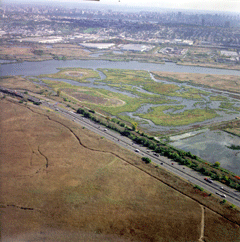
A bird’s eye view of the New Jersey Meadowlands, alongside the New Jersey Turnpike. (Courtesy of the Louis Berger Group)
CURWOOD: OK, it’s time now for a quiz. What feature of the landscape helps with flood control, biological diversity, groundwater replenishment, and water purification?
If you answered wetlands, go to the head of the class. But the United States is now down to half the wetlands it had when the country was founded and thousands more acres of wetlands get paved over or filled in every year.
Living on Earth’s Ashley Ahearn reports on the booming industry of wetlands mitigation banking, its promises and perils.
[CAR/TRUCK BUMPING ALONG HIGHWAY]
AHEARN: Driving south from New York City the New Jersey Turnpike is lined with
power plants, sports arenas and an airport. But tucked in among the industrial complexes is a cement-encircled wetland Eden.

A bird’s eye view of the New Jersey Meadowlands, alongside the New Jersey Turnpike. (Courtesy of the Louis Berger Group)
AHEARN: On a sunny day Virginia Kop Kash, an ecologist with the New Jersey Department of Environmental Protection takes a boat out to inspect a section of the Meadowlands.
[BOAT ENGINE STARTED AND THEN REVVED TO SET SCENE ON WATER]
KOP’KASH: Oh that is so neat. You see it’s flying right there?
AHEARN: Yeah, what is it?
KOP KASH: Uh, an Osprey and it has a fish
AHEARN: That’s it coming around right there.
KOP KASH: Yeah
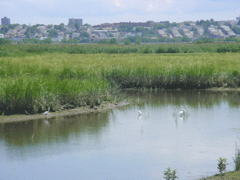
Egrets and other shorebirds make themselves at home.(Courtesy of the Louis Berger Group)
SAMMANS: This area was used as a sedimentation basin essentially for when they constructed the turnpike so they were pumping in sediments to build the bed for the roadway.
AHEARN: Ed Sammans is an environmental consultant. The Williams Companies bought these wetlands in 1995 and later hired Sammans to restore them. They removed sediment to reopen waterways through the marsh and recreate the original ecosystem. But the company didn’t just do it out of the goodness of its heart. It was a business proposition: Improve wetlands and make money.
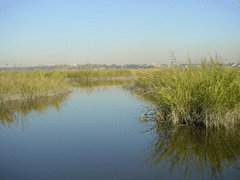
The Williams Companies dug channels to re-circulate water and rejuvenate the wetland. (Courtesy of the Louis Berger Group)
AHEARN: Rich Mogensen oversaw the restoration of the Williams wetland. It cost the company six million dollars, and when they were done, they’d created what’s called a wetland bank. Then the company sold credits from their bank for 165,000 dollars a piece, to developers who wanted to build on other wetlands.
MOGENSEN: You’re talking maybe 30 million dollars in revenue on a 6 million dollar investment so that was a real good one. That’s a big winner.
AHEARN: The goal of wetland banking is no net loss of wetlands. So if one company restores some wetlands, it’s ok if another company destroys others, as long as the total acreage of wetlands in a state doesn’t decrease.
But critics say that equation just doesn’t add up; wetlands should never be intentionally destroyed. And while the Williams wetland bank has been termed a success, not all mitigation banks work well.
John Mack is an ecologist with the Ohio Environmental Protection Agency. He noticed that some of the wetland banks in his state weren’t healthy wetlands.
MACK: We were seeing what we thought was problems with some of the banks. They were large areas of open water or just were sort of otherwise what we were looking at as problems or failure.
AHEARN: Wetlands fail for lots of different reasons. Changes in water level, or pollution, can disrupt the intricate balance of salinity and oxygen levels in the water.
Mack says it’s easy to mistake a mud-bottomed pond for an intact wetland ecosystem.
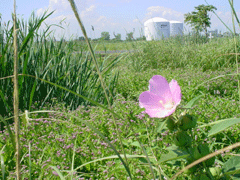
A hibiscus moscheutos, or swamp mallow, stands out before The Williams Companies facilities in the background.(Courtesy of the Louis Berger Group)
AHEARN: The state of Ohio declared some of these banks healthy. But Mack saw things a little differently.
MACK: The failure that we had was, from my perspective, is the lack of good ecologically based performance standards, sort of a quantitative goal that you’re gonna hit, or a target.
AHEARN: So Mack set about raising the regulatory bar. Over the past decade he and his colleagues at the Ohio EPA have been going through healthy wetlands in Ohio with a fine-toothed comb to create what’s called an Index of Biotic Integrity. It’s like an incredibly detailed wetland bingo sheet. You can’t win unless you have all the right chips in place: soil composition, plant species, invertebrates, amphibians, and on up the food chain.
But even if state regulators start using the biotic index to approve mitigation banks, Mack says there just aren’t enough regulators on the local level to make sure the banks are keeping up with the guidelines. Wetland Banker Rich Mogensen agrees.
MOGENSEN: One of the primary problems is the fact that they just don’t have the people to oversee these. They’re too busy issuing permits for Wal-Marts to fill in wetlands and they’re not really focused on proper mitigation techniques.
AHEARN: And as it turns out, wetland bankers don’t often have the scientific background to make up for a lack of specific scientific guidance in state regulation. Rich Mogensen has college degrees in biology and geology, but he says that’s not the norm for many of his colleagues.
MOGENSEN: It’s interesting in that there’s not a whole lot of hardcore science people. They tend to be lawyers, they tend to be utility companies and also timber companies.
AHEARN: The federal guidelines for mitigation banking haven’t been revamped since the first banks were created almost twenty years ago. Palmer Hough is a scientist for the U.S. Environmental Protection Agency’s wetland division. He says the scientific definition of what makes a healthy wetland is now more specific, and the federal guidelines need to be updated.
HOUGH: We thought we knew what we needed to measure in order to answer the question is this a successful wetland restoration project and low and behold as our understanding of these natural systems evolved, we realized wow, we weren’t really asking ourselves the right question ten or 15 years ago.
AHEARN: Hough is working on a new set of wetland management standards the EPA will release in the beginning of 2007. But he says it will still be up to the individual states to define what a healthy wetland looks like in their neck of the woods, and to make sure wetland bankers adhere to that definition.
For Living on Earth, I’m Ashley Ahearn.
Related links:
- New Jersey Department of Environmental Protection
- Marsh Resources Inc.
- "Ecological Assessment of Ohio Mitigation Banks: Vegetation, Amphibians, Hydrology and Soils" by J. Mack and M. Micacchion.
- The EPA on Wetland Mitigation Banking
[MUSIC: Mike Ladd ‘Jet Pack’ from ‘!K7 150 Compilation’ (!K7 - 2006)]
CURWOOD: Coming up: a landmark clean air case will have its day in the Supreme Court of the United States. That’s just ahead on Living on Earth.
[MUSIC: Hoagy Carmichael “March of the Hoodlums” from ‘Stardust, and Much More’ (BMG Entertainment - 1971)]
[THEME]
Clean Air Battle Heads to Supreme Court

(Photo: Phillip J. Redman, U.S. Geological Survey)
CURWOOD: It’s Living on Earth. I’m Steve Curwood.
The U.S. Supreme Court is getting set to decide a complex Clean Air case that could raise costs for certain coal-fired power plants and reduce pollution for people who live downwind. The case dates back to the Clinton Administration, when the Environmental Protection Agency tried to enforce a tough section of the Clean Air Act called New Source Review. Power companies fought back and the Bush administration tried to relax the rules.
Living on Earth’s Jeff Young followed the twisting road this case has taken from coal country to the highest court in the land.
[SUPREME COURT CROWD AND TRAFFIC]
YOUNG: Just after the justices hear a case, the Supreme Court’s grand white marble plaza fills with reporters, cameramen and curious onlookers. Usually they gather around the attorneys who have just argued a case. This time the media gaggle also hears from a physician.
BALBUS: You may be asking the question why is a doctor is standing up here on the steps of the Supreme Court.
YOUNG: John Balbus is with the group Environmental Defense, which helped bring the case against Duke Energy. Balbus doesn’t want the highly technical details of this case to obscure what he says it’s really all about.
BALBUS: It’s really about reducing the burden of death and disease that this nation is experiencing now in part from these aging, highly polluting power plants.
YOUNG: Public health advocates estimate the soot from the 50 dirtiest coal-fired power plants kills anywhere from five thousand to nine thousand people a year. Power companies like Duke Energy say the government’s enforcement under New Source Review is not a fair or effective way to reduce that pollution. Duke Energy’s attorney in the case, Carter Phillips, says Duke made changes to its power plants in keeping with the law, at least, as they understood it.

(Photo: Phillip J. Redman, U.S. Geological Survey)
YOUNG: The fight over coal-fired power plants has raged on like this ever since the Clinton Administration’s EPA went after power companies for making changes that increased emissions. Eric Shafer was head of enforcement for EPA back then. He says older power plants were "grandfathered in" under the clean air act because no one thought they’d still be around this many decades later.

In 2005, half of United States electric power was generated from coal.(Courtesy of National Institute of Standards and Technology)
YOUNG: And Schaeffer says many old power plants were expanding.
SCHAEFFER: Now, if you take an old dirty power plant that’s operating 25% of the time and you bring it back to full time operation without any pollution controls, you get a lot more air pollution.
YOUNG: Schaeffer says that extra pollution is obvious if you measure the total annual emissions from a facility. And that’s what’s at the heart of the case before the Supreme Court: Whether the law says you should use the annual emissions as the basis for enforcement. Many of the power companies don’t think so. Scott Segal represents power companies in a group called the Electric Reliability Coordinating Council. Segal says emissions should be measured hourly, not at the annual rate.
SEGAL: If you adopt an annual test, it makes it much more difficult to undertake process improvements at your power plant or even to do simple maintenance projects and as soon as you do that you create all kinds of perverse incentives which reduce the ability to control for emissions, undermine workplace safety and undermine the reliability of the power plants. And as a result there’s a lot at stake for power plants.
YOUNG: Appeals Courts are split on the matter, with two siding with the power companies and others with the government. Many suits are still pending as power companies fight on. But some companies took a different route.
[POWER PLANT SOUND]
YOUNG: Officials with Dominion Power are eager to show off the new pollution controls at the Mount Storm, West Virginia, Power Station, not far from the Virginia line.
Operations Manager Bill Wood and Dominion Vice President Pam Faggert say the plumes from the stacks towering above us now carry far less sulfur dioxide.

Dominion’s Mt. Storm Power Station (Courtesy of Dominion)
YOUNG: And then moving further over here to the right there’s a great big pile of black rock, that’s what makes it all happen, huh?
WOOD: Yes sir it is, that’s our coal storage pile. We use approximately 15 thousand tons a day.
YOUNG: Burning that coal powers a million homes but also made Mt. Storm one of the region’s dirtiest power plants. Now the new equipment has cut emissions by some 150 thousand tons a year. That, and improvements at other stations, will likely bring fewer asthma attacks and premature deaths in downwind communities. It’s a big job that takes big equipment. One piece, known as the SCR, works sort of like the catalytic converter on your car. Only this one is four-stories high.
FAGGERT: The size of the pollution control equipment is actually greater than the size of the boilers themselves.
YOUNG: And so the SCR is to target our nitrogen oxide emissions?
FAGGERT: Yes
YOUNG: And then the next is?
FAGGERT: The electrostatic precipitators we call them ESP’s, that’s the device to remove the particulate matter.
YOUNG: Then last come the scrubbers, enormous house sized devices that mix limestone to the flue gas. Because sulfur dioxide is acidic, it binds to the basic limestone instead of going up the stacks. Much of this new equipment came as a result of New Source Review. Dominion decided to settle with EPA rather than fight. Faggert says it cost 1.2 billion dollars
YOUNG: That sounds like big money to me. Is that big money to you?
FAGGERT: Yes that’s very big money (laughs). There’s no question 1.2 billion dollars is a lot of money but I think Dominion felt it was better to spend money on air pollution control equipment instead of lawyers. We’re pretty proud, very clean coal fired power station. We think it’s a good investment. Good for the company, good for the environment. A good deal.
YOUNG: Downwind at Shenandoah National Park, visibility is already slightly better and, for the past two years the park has had no bad days for ground level ozone.
[AMBI FADES]
YOUNG: Clean Air groups say that’s evidence the law works when it’s enforced. But most industry leaders say they could clean the air with less cost and fewer trips to the courthouse if they didn’t have to deal with New Source Review. And President George Bush agrees with them. In this 2003 speech Bush called the law complex and outdated.
BUSH: We're replacing the old rules with simple, clear, easy to understand rules that will allow utility companies to make routine repairs without enormous costs and enormous disruptions to their plants. And the country is going to be better off for it. (Applause.)
YOUNG: The proposed changes so angered Eric Schaeffer at EPA that he quit in protest. Schaeffer says Bush’s attempt to change the rules undermined the government’s effort to enforce the law.
SCHAEFFER: A terrible situation for government lawyers to be in.
YOUNG: So, when the New Source Review case went to the Supreme Court, the government’s attorney found himself without the support of this own client, the Bush Administration. In fact, the government tried to persuade the high court not to take the case. But the justices took it anyway, persuaded by the briefs by the group Environmental Defense A strange situation that might explain why the government’s lawyer did not join the media gaggle on the court’s steps.
[SUPREME COURT SOUND]
YOUNG: It fell to Environmental Defense’s attorney, Sean Donahue, to explain the government’s unusual position.
DONAHUE: Um, I think it’s a little awkward but that’s government. You’ve got to do some dancing sometimes.
YOUNG: Does it hurt your case, though?
DONAHUE: Um time will tell. Time will tell.
YOUNG: The Justices are expected to have a decision in about three months. For Living on Earth, I’m Jeff Young in Washington.
Related links:
- Dominion Virginia Power
- Environmental Defense on the New Source Review U.S. Supreme Court Case
- The Supreme Court docket for Environmental Defense V. Duke Energy Corporation
- Duke Energy on the New Source Review U.S. Supreme Court Case
- EPA's page on proposed changes to New Source Review
- Cornell Law School’s Overview of New Source Review
The Economics of Climate Change
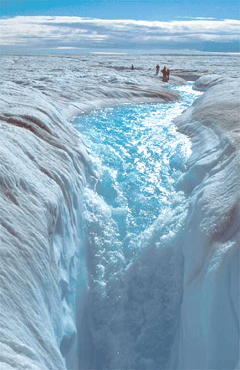
Due to rising temperatures, the Greenland Ice Sheet flows more quickly during summer melting. Here, meltwater flows into a large moulin. (Courtesy of Roger J. Braithwaite, The University of Manchester, UK)
CURWOOD: A new report from the top economist of the British government says if climate change continues unchecked, it would likely cripple the global economy. Sir Nicholas Stern is the head of the UK’s economic service and he issued his report in advance of the Kyoto Protocol’s next round of negotiations scheduled for later this month in Nairobi, Kenya.
The current phase of the Kyoto Protocol requires modest emissions reductions by industrialized countries. The next phase of Kyoto begins in 2012. It is expected to call for much deeper cuts in greenhouse gases and include mandatory limits on emissions from the large developing nations, including China, Brazil and India.
Jennifer Morgan is the Climate and Energy Security Director at Third Generation Environmentalism and she joins me now to discuss the Stern report. Hello there.
MORGAN: Hello.
CURWOOD: So, what’s the significance of this report?
MORGAN: I think the significance of the Stern report is it’s the first time when the world has been offered a mentally robust economic analysis on the challenge of climate change. Both from the side of how much the impacts of climate change would cost society and how much it would cost or benefit society to avoid those impacts. And in fact that there is not a need to choose between avoiding climate change and promoting growth and development. We can do both at the same time.
CURWOOD: So what are the most important findings from your perspective?
MORGAN: Well number one is what he’s found on the cost of the impacts. He finds that the world’s economy could face massive depression. That the costs if urgent action are not taken could be along the lines of World War I, World War II and the Great Depression combined. Up to 20 percent of GDP each year could be the cost of the impacts of climate change. And he finds that actually in order to implement risk reduction of those cost you would need to invest just about one percent of GDP by 2050 to avoid that kind of depression.
CURWOOD: Now, why was this study commissioned in the first place?
MORGAN: I think that Gordon Brown, the Secretary of Treasury of the United Kingdom commissioned it because he wanted more information on the economics of climate change. There have been a lot of studies done, a lot of controversy, a lot of squabbling about numbers. I think he was looking to get one of the world’s top economists to step in and give him some hard nosed numbers on the problem.
CURWOOD: Now you say squabbling over numbers. What squabbling? What numbers?
MORGAN: Well, the climate change debate, as many may have probably heard, is often ripe with industrial groups claiming that doing something about climate change will bankrupt the economy. And I think what the UK government was looking for was an impartial voice that looked at all of the literature and did some really hard number crunching to come up with something that was credible.
CURWOOD: Jennifer, could you give us some specifics of the economic effects that Sir Nicholas is talking about here?
MORGAN: Well, for example, what happens when glaciers melt? The impacts of glacier melt on fresh water supply, and then of food security issues that you think of the Himalayas and billions of people dependent on those glaciers. The cost of first a flood from the melting of the glaciers and then a drought. And the food security issues around that for a country like India.

Due to rising temperatures, the Greenland Ice Sheet flows more quickly during summer melting. Here, meltwater flows into a large moulin.(Courtesy of Roger J. Braithwaite, The University of Manchester, UK)
MORGAN: He finds a number of different dividends. He finds that the benefits of investment would exceed the costs by 2.5 trillion dollars annually. And that the market for green technologies could be worth at least 500 billion a year by 2050. There’s actually quite a lot of money to be made from this.
CURWOOD: So as I understand it Sir Nicholas Stern is going to present his findings at the meeting of the parties of the Kyoto Protocol at the UN climate change convention in Africa, later in November. What can we expect out of this meeting?
MORGAN: My hope is that this meeting, which is the first climate change meeting in Africa, will result in much greater support for adaptation efforts in Africa. In other words, helping Africa deal with the impacts of climate change that are already occurring and will happen at a much more devastating rate in the future. I would also hope that it would spur greater movement on the solutions side. Right now we’re in a bit of a stuck phase I would say where we’re in a negotiation that is supposed to conclude next year. Well this report would give all countries impetus to speed those up, to meet more often, to come to a conclusion by next year, to set forward the post 2012 phase or the next phase of the Kyoto Protocol. And to set it up so that it is absolutely impossible for the United States to stay out of the system.
CURWOOD: Tell me more about what the Kyoto process needs to get negotiated by next year.
MORGAN: Well, there is a range of different tracks in the negotiations right now. One has to do with what developed countries are willing to do further. The Kyoto Protocol includes binding targets to reduce emissions from developed countries but it’s only in the range of five percent by 2012. And what we need is something in the range of 30 percent by 2020.
CURWOOD: Jennifer Morgan is the climate and energy security director for Third Generation Environmentalism. Thank you so much.
MORGAN: Thank you.
Related links:
- The Stern Review on the Economics of Climate Change
- The Kyoto Protocol
- The United Nations Framework Convention on Climate Change
Climate Friendly Assistance
CURWOOD: And now, I’d like to offer some comments. Now if you’re like me, you may have bought some efficient light bulbs and thermostats to save some money and energy. But let me ask you: if you are concerned about global warming, why don’t you have solar cells on the roof of your home? And what about all that geothermal energy found just a few feet below your house that could provide most of the heating and cooling you would ever need?
Now I don’t have a big solar array or geothermal heat pumps, and it’s all about the money. I know over the long run solar, geothermal, small scale wind and sophisticated energy conservation measures would pay for themselves and then some. But it’s much easier to write those monthly checks to the electric and gas or oil utility instead of coming up with as much as $50 or $100,000 to make my home more climate-friendly.
So I’d like to make a proposal. What if we were to finance low and no carbon home energy systems the way we finance houses? You can borrow most of the money to buy a residence and pay it back over as many as 30 years if you like, and it keeps the monthly payment close to what rent would be. Thanks to government backed long term financing structures, two out of three of us own our own homes or at least have a direct deal with a bank.
So how about public guarantees for long term loans for home systems that drastically reduce the use of carbon and other global warming gases? The payments would be the same or maybe even less than current utility bills, if folks can pay over 30 years. And those bills won’t go up - the sun doesn’t charge more if there’s a war or a hurricane. There’s another dividend - designing and installing all those low carbon home energy systems will put plenty of people to work right here in America.
A state, county or city could do it, and were the federal government to do it we could call financing agency the low carbon mortgage assurance corporation - LC MAC. And what if folks default? Let’s say five percent do - and that’s way above current mortgage default rates. That would then mean for every billion dollars worth of low carbon energy infrastructure taxes might have to cover 50 million dollars. Five cents or less on the dollar to build infrastructure to fight global warming, promote local jobs and improve national security sounds to me like a terrific deal… That’s my view. But what do you think?
Send us your comment. The address is comments at loe.org. Or call 800 218 9988. That’s 800 218-9988.
[MUSIC: Goddamn Electric Bill “Witching Hour” from ‘Nothing Concrete 2005 Sampler’ (99X/10 Records & Tapes – 2006)]
CURWOOD: Just ahead: reeling in the history of one of the world’s best sporting rivers.
First, this Note on Emerging Science from Jennifer Percy.
Emerging Science Note/Social Birds

The spice finch is also referred to as "nutmeg mannikin" and was one of the species used in the UC/San Diego study. (Courtesy of Dave Behrens)
[SCIENCE THEME]
PERCY: Flashback to high school. Were you part of a social group, or at least did you desperately want to be? Or maybe you just preferred to be alone. Scientists at the University of California, San Diego are studying birds to better understand why certain people flock together and others prefer the life of a loner. They found the secret lies deep in our brains.
The researchers traveled to South Africa to find the perfect subjects: a group of closely related waxbills and finches that are similar in all ways but one - some species are territorial, and live in colonies of about 100, and the rest are solitary, living alone or with a monogamous mate.

The spice finch is also referred to as "nutmeg mannikin" and was one of the species used in the UC/San Diego study. (Courtesy of Dave Behrens)
The scientists believe vasotocin plays a similar role in humans. Though they don’t know why some of us have more neuron activity than others, they hope these findings could one day help alleviate shyness and lead to a cure for social anxiety disorder.
But they warn we are a long way from being able turn a misanthrope into a party-going socialite.
That’s this week’s note on emerging science. I’m Jennifer Percy.
Related link:
Groups And Grumps: Study Identifies 'Sociality' Neurons
CURWOOD: And you’re listening to Living on Earth.
If you enjoy listening to Living on Earth, chances are you have some pretty good ideas about things that the program should cover. Good news, bad news or just plain interesting--if you think it would make a worthwhile story for the radio, please get in touch. You can zap us an email at comments @ l-o-e dot org. Or call the Living on Earth listener line, at 800-218-9988. That’s 800-218-99-88.Or write 20 Holland Street, Somerville, Massachusetts 02144. It’s Living on Earth on PRI - Public Radio International.
[MUSIC: Hoagy Carmichael “Come Easy, Go Easy Love” from ‘Stardust, and Much More’ (BMG Entertainment - 1971)]
Fishing With Hoagy
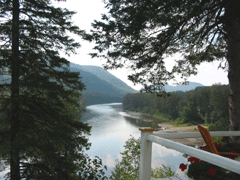
The Grand Cascapedia River (Courtesy of Bob Carty)
CURWOOD: It’s Living on Earth. I’m Steve Curwood. Every summer, a small group of anglers pay a lot of money – around ten thousand dollars a week - to cast a line into a river on the Atlantic coast of Canada. They do it because the Grand Cascapedia has produced three quarters of the largest Atlantic salmon ever caught in North America.
And not only that – the Cascapedia’s salmon stocks are in good shape while many salmon rivers in eastern Canada are in decline and most in the eastern United States are barren. A key reason for that lies in the Cascapedia’s fabled history, the subject of a new book by Hoagy Bix Carmichael. He’s the son of the great singer-songwriter, Hoagy Carmichael who gave us Georgia on My Mind and Stardust.
Producer Bob Carty spent some time fishing with Hoagy Bix Carmichael – talking about history and his father’s music, and about the river he loves.
[MUSIC: The Mills Brothers “Up a Lazy River” from ‘The Mills Brothers’]
CARMICHAEL: There are a number of rivers mentioned in Dad’s songs. This one is not a lazy, this river can be a torrent in fact, not “up a lazy river.” I wish Dad had been a fisherman – it would have been something that we could have shared together.
CARTY: Wherever Hoagy Bix Carmichael goes, his father, and his father’s music are never far away, even when he’s standing on slippery rocks, waist deep in the fast-moving waters of the Grand Cascapedia River. Hoagy swings his 11-foot pole back and forth, looping the line in broad arcs until it casts a fly 30 yards out across the rapids. The river takes it downstream, and Hoagy watches with the intensity of a sprinter waiting for the starter’s gun.
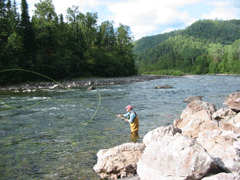
Hoagy casting off.(Courtesy of Bob Carty)
CARTY: The Grand Cascapedia River tumbles out of the remnants of the Appalachian mountain chain in the Gaspe peninsula of Quebec. Its pristine waters cascade down 100 miles of rapids, cutting a narrow valley through dense pine forests. Along the way, in more than 150 pools, there are salmon. From the riverbank you can actually see them - 20 and 30 pounders – floating there on the bottom. Hoagy’s fishing guide, Lee Forn, can’t help but remember what can happen when a fly touches water.
FORN: It was about 20 min before dark, the water just exploded. Had him on for over 2 hours, 60 inches long, 28 inch girth on him – monster fish.
CARTY: But for now, the monster fish are just ignoring Hoagy’s fly. But that’s OK.
CARMICHAEL: A friend of mine said “let me find a good fish and if I do I’ll get a thousand dreams out of it.
CARTY: Hoagy has spent five years of his life writing about this river, not just because of its fish, but because in a way, the river helped save his life.
[MUSIC: Louis Armstrong “Stardust” from ‘Louis Armstrong: Smithsonian Box Set Collection’]
CARTY: Hoagy Bix Carmichael was born in 1938 in Los Angeles and grew up there in the years when his father was at the top of his career – composing hit tunes, starring in Hollywood movies, hosting radio programs, touring around the nation and the world.
As a kid he used to cast plugs into the backyard swimming pool and pretend to catch a big trout. As an adult he found a calling in public television – producing the Mr. Rogers and Julia Childs shows. He was also managing his father’s song catalogue – which meant getting royalties for every new recording of Georgia On my Mind or The Nearness of You. And that allowed him to enjoy his favorite river.
CARMICHAEL: I first came to the Grand Cascapedia in 1985 – I loved the beauty of the river, seeing a bald eagle land as I was casting for a rising 20 lb salmon that you fight for half-an-hour. It really did feel I needed to come back here.
[MUSIC: The Four Aces “Heart and Soul” from ‘The Best of The Four Aces’]
CARTY: And Hoagy Bix did come back here, almost every summer. Even the worst summer of his life. In 1999, Hoagy was diagnosed with a bad case of lymphoma. He had to have chemotherapy. His appendix burst. He was very ill. And it was just a week before he was due to go to the Cascapedia.
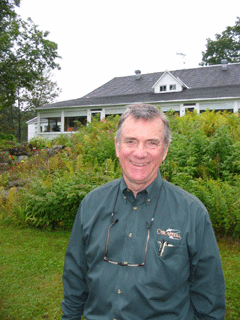
Hoagy B. Carmichael (Courtesy of Bob Carty)
[MUSIC : Hoagy Carmichael “Rockin’ Chair” from ‘Hoagy Sings Carmichael’]
CARTY: Hoagy’s father had always told him that if you look at a piano; there all kinds of new songs waiting there right on the keys … you just have to find them. And so Hoagy began to try to track down the details of the Grand Cascapedia’s history. In the 1880’s, the river was the near exclusive domain of the governors-general of Canada, the representatives of the British Queen. But in 1893, a group of American entrepreneurs bought them out. The best salmon river in the world was turned over to an elite club of American anglers.
[DOOR SLAMS]
CARMICHAEL: This is the original room of the old Cascapedia members - it was a small club of six to eight men at any one time: Mr. Vanderbilt – maybe the richest man in America, Henry Clay Frick, who worked with Andrew Carnegie and developed U.S. Steel. R.G. Dunn, Dunn & Bradstreet, still bears his name – in fact R.G. Dunn employed four of the presidents of the United States, including Abraham Lincoln. And they all brought man servants, some brought two – it’s sort of all the simplicity money can buy.
CARTY: American domination of fishing on the Grand Cascapedia would continue for the next 90 years. Raising not a little amount of debate. The Micmac native people had used these territories, and fished the salmon, for centuries before the sportsmen arrived. John Martin is the local Micmac chief.
MARTIN: I remember speaking with an elder a few years back and I said “Yeah, you must have been doing a lot of fishing in your time when you were a young fellah” and he said, “No, we couldn’t fish, we’d get thrown in jail, we’d get chased off the river. They wouldn’t allow us to fish. And yet, it was our God given right to do so. Guards and gates set up and we were prevented from exercising our rights.
CARTY: But there was an upside to private ownership of fishing rights. It meant there were few anglers and those anglers had a self-interest in preserving the salmon stocks. Over the years they limited the number of rods that could be used at any one time, and the number of fish caught on any one day. They used their political connections to oppose plans to build dams on the river.
CARMICHAEL: That would have made this river a lake – and salmon don’t like lakes – and they would never have gotten up and it would have been dead. They worked very hard and made a few key phone calls – and the proposal was stopped. You quite often find that if you own something you tend not to let it run down – it’s your preserve. They’ve always been able to limit the amount of fishing that’s been on this river.
CARTY: That’s a view shared by many locals. Mary Robertson was born and raised in the valley, and now she’s the director of the Grand Cascapedia Museum.
ROBERTSON: I heard a wonderful quote and it was a gentleman from this area and he said, “If it had not been for the Americans on this river, there would not be a salmon left in the river.” These people came into this river, it became let’s say their playground, so they knew they had to protect their resource. Whey you look at this situation from the outside you’re saying “Oh yes what is it, the Americans came in and they had the rights to the river and we the local people can’t fish. But some of the local people were able to make a bit of money. They worked for them, carpentry skills were used. The women were able to work in the camps and to this day, that continues. There’s a close bond between the people who have the camps, and the local people.
[MUSIC: Hoagy Carmichael “Some Days There Just Ain’t No Fish” from ‘Buttermilk Sky’]
CARMICHAEL: Some days there just ain’t no fish – other days there might be – and that’s what keeps the fisherman alive – you think you’re gonna catch something. You’re just sure of it.
[MUSIC: Hoagy Carmichael “Some Days There Just Ain’t No Fish” from ‘Buttermilk Sky’]
CARMICHAEL: We’re in the room right now, the bedroom that Jimmy and Roslyn Carter stayed in when they came fishing here. That’s Bing Crosby, a picture of Mr. Crosby up here.
CARTY: Over the years, more and more celebrities have come to the Grand Cascapedia. But the river is no longer run as a private club. In the late 1970’s, the provincial government of Quebec kicked out a lot of foreign fishing clubs and set up government agencies to run the rivers. It was an egalitarian idea – offering easy and relatively cheap access to salmon fishing for everyone. But many of those rivers have been over-fished.

The Grand Cascapedia River (Courtesy of Bob Carty)
One thing they decided was that to protect the resource, fishing would be kept expensive. Through a lottery, some lucky members of the public can have access to fishing pools for as little as $60 a day. For most anglers it’s a bit more costly.
CARMICHAEL: For a day for two people it’s somewhere in the area of 1300-1400 dollars. When you think about it, eight or nine hours fishing on a river that could bring you the biggest fish of your life, or the biggest fish in Canada, it’s not too bad.
CARTY: The sports fishery on the Cascapedia supports about 130 jobs in the valley. It brings in more than four million dollars a year – and given that about a thousand fish are caught each year, that means that each fish caught on the fly is worth four thousand dollars.
CARMICHAEL: Lee Wolfe, the great angling writer and fisherman, said, a salmon is too valuable to only catch once. He’s right about that.
CARTY: Which is why the Cascapedia Society supports “catch and release”. Hoagy hasn’t killed a salmon in eight years. You can get a license to take a salmon away to your dinner table. But 87% of the salmon landed on the Cascapedia are now set free. And that has increased the average weight of the fish to about 20 pounds.
Meanwhile, a deal with Greenland’s commercial fish operators has got them fishing for anything but salmon, and that is helping stocks return to a number of rivers, including the Grand Cascapedia. The result: back in the 1950’s there were only 250 large salmon in this river. This year biologists counted 2,700. That’s double the number in all rivers in the U.S. Northeast. Yet, there still are serious concerns for the future.
[MUSIC : Geoff Muldaur & Amos Garrett “Washboard Blues” from ‘Washboard Blues’ (Vivid Sound)]
CARMICHAEL: The greatest threat to this river and all rivers is global warming of course because we have weather patterns and warmer water that will affect this river in 30 or 40 or 50 years and that scares me a lot. It’s fragile, it’s on the edge of being fragile.
[TRUCK GOES BY]
CARMICHAEL: There is a road running along here, used by tourists, fishermen, and a lot of logging trucks.
CARTY: Living with the logging industry is a huge challenge for this river. A few years ago local residents, natives and anglers pressured the forestry companies to reduce the amount of silt run-off. But clear-cutting in the watershed creates a long-term problem, a problem Cascapedia Society manager Marc Gauthier explains to me as we take a canoe ride up the river.
[POLLING UP RIVER]
[FISH JUMPS]
GAUTHIER: “Look at that. That’s a big fish. They jump out of the water. That’s Salmo Salar, that’s the latin name. Salar meaning, “the leaper”.]
The river is aging. We’re getting flash floods. The logging industry tells us we have as much water as before, but that water passes by in three days instead of giving us water throughout the season. The flash floods erode the bank. You get wider river and shallower. We’re losing pools on a yearly basis. So we have to control logging so it doesn’t interfere with aquatic wildlife.
[RIVER BABBLE]
CARMICHAEL: Lady Amherst, that’s a D-fly, what’s called a stone fly. Double hook gives you a little more weight.
CARTY: Back in his fishing pool, Hoagy is going through his fly wallet. Maybe a change will bring a bite. If it does he’ll land the fish, give it a pat and let it go.
CARMICHAEL: There is a sense of conservation here where you are not trying to pound these fish to death. You fish and you go home. It does work.
CARTY: For Living on Earth. I’m Bob Carty on the Grand Cascapedia River in the Gaspe of Quebec.
Related links:
- Hoagy B. Carmichael’s book "The Grand Cascapedia River: A History, Volume One"
- The Cascapedia River Museum
[MUSIC: Hoagy Carmichael “Lazy River” from ‘The Classic Hoagy Carmichael’ (CBS Records)]
CURWOOD: To find out more about the Cascapedia River, go to our website, www.loe.org, where you can hear our program any time.
[MUSIC: Hoagy Carmichael “Lazy River” from ‘The Classic Hoagy Carmichael’ (CBS Records)]
CURWOOD: Next time on Living on Earth we’ll bring you the key results of the mid-term elections and analyze voter choices and the potential impact on conservation, energy and environmental protection in the next congress. That’s the environment and the elections, next time on Living on Earth.
[WATER SOUND]
CURWOOD: We leave you this week with some more water music.
[WATER SOUND]
These tinkling melodies are created by asuikinkutsu, which literally translates as “water harp cave.” This clay cistern-like device is designed to catch the overflow of water from stone drinking basins in Japanese gardens. Yu Wakao recorded this symphony at a garden in Kyoto, Japan.
[WATER SOUND]
CURWOOD: Living on Earth is produced by the World Media Foundation. Our crew includes Ashley Ahearn, Eileen Bolinsky, Bruce Gellerman, Ingrid Lobet, Emily Taylor and Jeff Young - with help from Bobby Bascomb, and Kelley Cronin. Our interns are Ian Gray and Jennifer Percy. Dennis Foley is our technical director. Alison Lirish Dean composed our themes. You can find us at loe dot org.
I’m Steve Curwood. Thanks for listening.
ANNOUNCER: Funding for Living on Earth comes from the National Science Foundation, supporting coverage of emerging science; And Stonyfield farm organic yogurt and smoothies. Stonyfield pays its farmers not to use artificial growth hormones on their cows. Details at Stonyfield dot com.
Support also comes from you our listeners, the Ford Foundation, the Town Creek Foundation, and the Saunders Hotel Group of Boston's Lennox and Copley Square Hotels. Serving you and the environment while helping preserve the past and protect the future, 800-225-7676.
Living on Earth wants to hear from you!
Living on Earth
62 Calef Highway, Suite 212
Lee, NH 03861
Telephone: 617-287-4121
E-mail: comments@loe.org
Newsletter [Click here]
Donate to Living on Earth!
Living on Earth is an independent media program and relies entirely on contributions from listeners and institutions supporting public service. Please donate now to preserve an independent environmental voice.
NewsletterLiving on Earth offers a weekly delivery of the show's rundown to your mailbox. Sign up for our newsletter today!
 Sailors For The Sea: Be the change you want to sea.
Sailors For The Sea: Be the change you want to sea.
 The Grantham Foundation for the Protection of the Environment: Committed to protecting and improving the health of the global environment.
The Grantham Foundation for the Protection of the Environment: Committed to protecting and improving the health of the global environment.
 Contribute to Living on Earth and receive, as our gift to you, an archival print of one of Mark Seth Lender's extraordinary wildlife photographs. Follow the link to see Mark's current collection of photographs.
Contribute to Living on Earth and receive, as our gift to you, an archival print of one of Mark Seth Lender's extraordinary wildlife photographs. Follow the link to see Mark's current collection of photographs.
 Buy a signed copy of Mark Seth Lender's book Smeagull the Seagull & support Living on Earth
Buy a signed copy of Mark Seth Lender's book Smeagull the Seagull & support Living on Earth

